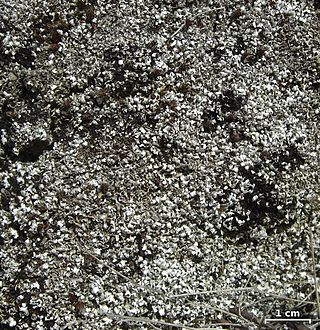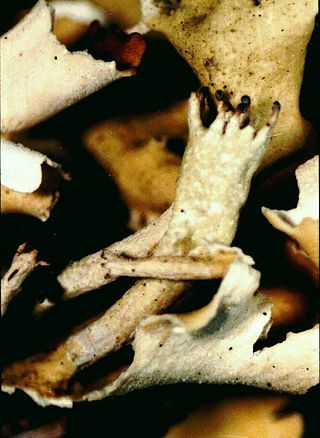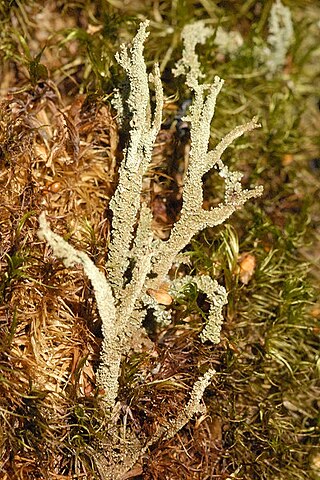
Cladonia rangiferina, also known as reindeer cup lichen, reindeer lichen or grey reindeer lichen, is a light-colored fruticose, cup lichen species in the family Cladoniaceae. It grows in both hot and cold climates in well-drained, open environments. Found primarily in areas of alpine tundra, it is extremely cold-hardy.

Cladonia is a genus of moss-like lichens in the family Cladoniaceae. They are the primary food source for reindeer/caribou. Cladonia species are of economic importance to reindeer-herders, such as the Sami in Scandinavia or the Nenets in Russia. Antibiotic compounds are extracted from some species to create antibiotic cream. The light green species Cladonia stellaris is used in flower decorations.

The Cladoniaceae are a family of lichen-forming fungi in the order Lecanorales. It is one of the largest families of lichen-forming fungi, with about 560 species distributed amongst 17 genera. The reindeer moss and cup lichens (Cladonia) belong to this family. The latter genus, which comprises about 500 species, forms a major part of the diet of large mammals in taiga and tundra ecosystems. Many Cladoniaceae lichens grow on soil, but others can use decaying wood, tree trunks, and, in a few instances, rocks as their substrate. They grow in places with high humidity, and cannot tolerate aridity.

Cladonia fimbriata or the trumpet cup lichen is a species cup lichen belonging to the family Cladoniaceae.
Teuvo ("Ted") Tapio Ahti is a Finnish botanist and lichenologist. He has had a long career at the University of Helsinki that started in 1963, and then following his retirement in 1997, at the Botanical Museum of the Finnish Museum of Natural History. Known as a specialist of the lichen family Cladoniaceae, Ahti has published more than 280 scientific publications. A Festschrift was dedicated to him in 1994, and in 2000 he was awarded the prestigious Acharius Medal for lifetime contributions to lichenology.

Cladonia cariosa, the split-peg lichen or the split-peg soldiers cup lichen, is a species of fruticose, cup lichen in the family Cladoniaceae. It was first formally named by Erik Acharius in 1799 as Lichen cariosus and transferred to the genus Cladonia in 1827 by Kurt Polycarp Joachim Sprengel. It has a broad distribution, occurring in Europe, Asia, North America, and South America.

Cladonia turgida or the crazy-scale cup lichen is a species of cup lichen in the family Cladoniaceae.

Cladonia deformis, also known as the lesser sulphur cup or the lesser sulphur cup lichen, is a light-coloured, fruticose, cup lichen belonging to the family Cladoniaceae. This lichen was first described as Lichen deformis by Carl Linnaeus in 1753, and transferred to the genus Cladonia in 1796 by Georg Franz Hoffmann.

Cladonia coniocraea, commonly known as the common powderhorn or the powderhorn cup lichen, is a species of fruticose, cup lichen in the family Cladoniaceae. It was first described by Heinrich Gustav Flörke in 1821 under the name Cenomyce coniocraea, until Kurt Polycarp Joachim Sprengel reclassified it under the genus Cladonia in 1827.

Cladonia digitata, commonly known as the finger cup lichen, is a cup lichen species in the family Cladoniaceae.

Cladonia squamosa or the dragon cup lichen is a species of cup lichen in the family Cladoniaceae.

Cladonia macilenta or the lipstick cup lichen is a species of cup lichen in the family Cladoniaceae.
Cladonia acervata is a species of cup lichen in the family Cladoniaceae. It has been found in Australia and New Zealand.
Cladonia albofuscescens is a species of cup lichen in the family Cladoniaceae. It is found in South America, and grows in tropical moist broadleaf forests.
Cladonia aleuropoda is a species of cup lichen in the family Cladoniaceae. It has been found in both South America and Central America, as well as a single instance in Mexico. Its substrates include rocks and soil.
Cladonia anaemica is a species of cup lichen in the family Cladoniaceae. It is found in Brazil.
Verrucaria ahtii is a species of saxicolous (rock-dwelling) crustose lichen in the family Verrucariaceae. It is found in Finland, Lithuania, Russia, and Switzerland, where it occurs on calcareous pebbles.










